 |
 |
 |
 |
 |
 |
2005 Weetabix Women's British Open
For most of the last few years, there has been a distinct hierarchy among the Korean golfers on the LPGA tour. At the top of the pyramid you had 22 time winner and Hall of Famer-to-be Se Ri Pak. Se Ri was for a short while the alpha and omega of Korean women's golf, the most famous player, the best one, and the most influential. More than perhaps any other golfer on the LPGA tour, she has been responsible for the sea change that has produced the influx of Korean golfers now earning their living in America. Just below her was Grace Park, six time winner, Vare Trophy recipient in 2004, and superstar with lofty goals.
Below those two were the other two Seoul Sisters, Mi Hyun Kim and Hee-Won
Han. Both undeniably superstars who were used to finishing in the top
ten on the money list, they didn't have quite the gaudy records of the
top two players, but still had multiple wins and zillions of dollars to
their names.
Below the Big Four there were a bunch of other players who had distinguished
themselves in some way or another, but who did not have nearly the combination
of consistency and wins that the Big Four had. Among those players were
Gloria Park, two time winner on tour; Soo Yun Kang, who was a big star
in Korea but not yet one in America; and Jeong Jang, known as JJ. JJ had
managed the occasional great finish, and had some consistency, but was
by and large in the shadow of her good and equally tiny friend Mi Hyun
Kim. So much were they associated together in the press over in Korea
that they even had the same nickname (almost). Mi Hyun has been known
as 'Super Peanut', because, like a peanut, she is compact but tough. JJ
was known as 'Ultra Peanut', or sometimes 'Super Ultra Peanut', for similar
reasons.
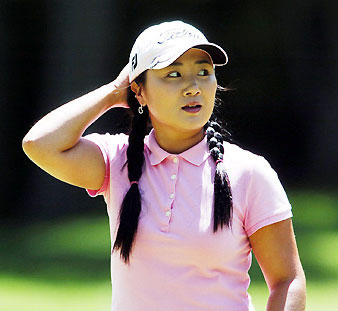
Jeong Jang, the 'Ultra Peanut'
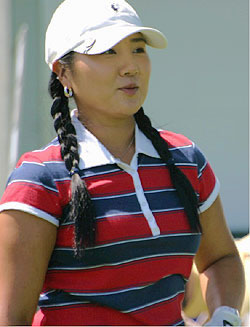
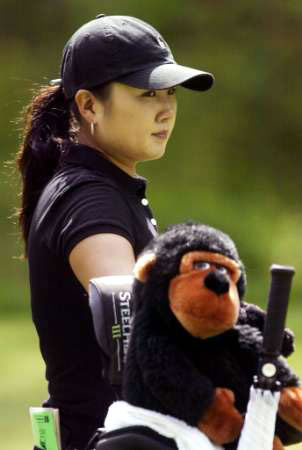
Jeong Jang back in 2002
Like a lot of these lesser known Korean golfers, JJ had an impressive
amateur record before coming to the LPGA. She started playing golf when
she was 14, inspired, as her father said, by Se Ri Pak, a girl who lived
in her home town of Daejeon, and who at one time had been so close to
her family that she would even come over to play with JJ's older sister
(they both attended the same Kindergarten). Se Ri had started playing
golf a few years previously, and had already managed to win some of the
biggest amateur and pro events in Korea as a high school student. JJ found
that she, too, was naturally gifted at golf, and in just a few years,
it was her turn to become a surprise teenage prodigy.
But, as the legend goes, everything might have very easily turned out
differently. Before JJ started playing golf, her dad was a voracious golfer
himself, spending endless amounts of his free time on a driving range
near their house in Daejeon. One day, her mother told Jeong to go to the
range to fetch her father. She did, but her dad took the opportunity to
ask JJ to hit a few shots herself, just for fun. He quickly realized that
she had a real talent, and before long, it was Jeong who was spending
long hours on the range, under her father's guidance, honing her golf
game.
About six months later, Jeong entered her first amateur golf competition. Who should she be paired with in her very first competitive round but Young Kim, who would later finish just behind JJ at the Women's British Open in 2005. But at this time, Young was just another young golfer trying to learn the game. After the first round, most of the girls shot in the 80s, but Jeong's score was a dismal 116. Young tried to make her feel better by joking about how determined she had looked as she hacked her way around the course, but it was a mortifying experience for JJ. Indeed, it was almost enough to convince her that she did not have what it took to compete at golf.
By 1997, JJ had become one of the best amateur golfers in her age range in Korea. But she was still not convinced that she could ever become a truly top golfer. Standing just 5 feet tall (and maybe even that is a generous guess), JJ seemed an unlikely athlete to compete with the long hitters on the LPGA tour. Then fate once again intervened. Alison Nicholas, who had recently won the US Women's Open, appeared at a local tournament. Nicholas herself was one of the shortest women on the LPGA, and Jeong's dad told JJ to go stand next to her and compare herself to the diminutive Brit. JJ was too shy, but her dad insisted again, and so she reluctantly walked up to Nicholas. She was surprised to see that she was only slightly shorter than Nicholas was. If Nicholas could win a Major, perhaps JJ could as well!
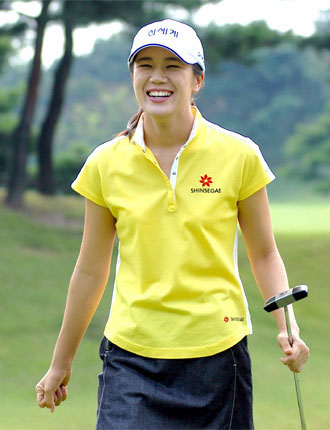
JJ had an encounter early in her career
with Young Kim
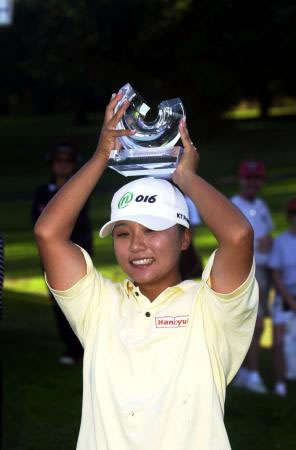
Super Peanut trumped Ultra Peanut in 2000
In 1999, Jeong decided to turn pro and pursue golf on the LPGA tour, just like her role model Se Ri Pak and good friend Mi Hyun Kim had done. She managed to get through Q-School in 1999, and in 2000 played as a non-exempt player on tour. That year she played surprisingly well, notching five top tens in all. But the highest moment came at the Safeway Classic in Portland, Oregon, where she managed to take the lead all the way into the clubhouse on the final day, then had to wait to see if anyone could catch her. Ironically, the only one who could was her old friend Mi Hyun, although it took a clutch birdie on the final hole for her to do it, after a triple bogey on 17 had nearly derailed her. They went into a playoff, and Kimmie eventually beat her friend for her third career title. Super Peanut trumped Ultra Peanut in this case.